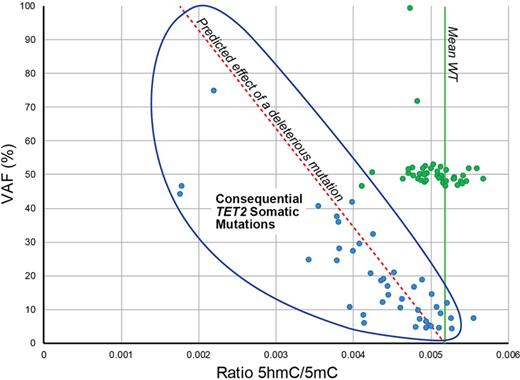Abstract
BACKGROUND. Epigenetic dysregulation resulting from acquired mutations in the methylcytosine dioxygenase gene TET2, responsible for the conversion of 5-methylcytosine (5mC) to 5-hydroxymethylcytosine (5hmC), and the methyltransferase gene DNMT3A, responsible for the methylation (5mC) of cytosine, is emerging as an important predisposing factor for age-associated hematological cancers. This study describes an improved and validated analytical method to quantify global 5hmC and 5mC levels in DNA samples by liquid chromatography-electrospray ionization-tandem mass spectrometry-multiple reaction monitoring (LC-ESI-MS/MS-MRM).
METHODS. Genomic DNA from blood cells is hydrolysed using DNA Degradase Plus and stopped by the addition of formic acid (0.1%) spiked with stable isotope labeled internal standards (2 nM of 5-hydroxymethyl-2'-deoxycytidine-d3 (2H3-5hmC), 40 nM of 5-methyl-2'-deoxycytidine-d3 (2H3-5mC) and 200 nM 2'-deoxyguanosine-13C10,15N5 (15N5-G). Global 5-methyl-2'-deoxycytidine (5mC) and 5-hydroxymethyl-2'-deoxycytidine (5hmC) levels are assessed by LC-ESI-MS/MS-MRM. 2.5 ul containing 12.5 ng of hydrolysed DNA and internal standards is injected onto a reverse phase ultra-performance liquid chromatography column (Agilent 1290 Infinity UHPLC Systems with Waters ACQUITY UPLC HSS T3 Column, 100Å, 1.8 µm, 2.1 mm X 100 mm) connected to a triple quadripole mass spectrometer (Agilent 6460 QQQ) operating in positive ion MRM mode. MRM transitions used are for 2H3-5hmC m/z 261.2>145.1, 5hmC m/z 258.2>142.1, 2H3-5mC m/z 245.2>129.1, 5mC m/z 242.2>126.1, 15N5-G m/z 283.3>162.1, G m/z 268.3>152.1. Global percentages of modified cytosine are estimated using deoxyguanosine (G) as surrogate for total cytosine (C). For the validation phase, a cohort of 472 asymptomatic aging individuals were sequenced at high coverage (95% >500x) for mutations in TET2 (Ampliseq, Ion Proton NGS) and then analysed by mass spectrometry.
RESULTS. The analytical method yields linear responses across the biological range for all monitored nucleotides. For 5hmC, the limit of quantification (LOQ) is 50 amol (20 pM) with an interday accuracy of 103% and a precision of 3.3%. This sensitive and robust method was validated on a cohort of asymptomatic aging individuals (n=472) to test its capacity to identify the epigenetic phenotype associated with TET2 loss-of-function mutations: a severe reduction in 5hmC level but not in 5mC level, resulting in a reduced 5hmC/5mC ratio. In the cohort, TET2 mutations were associated with 29% reduction in 5hmC/5mC ratio compared to wild-type individuals (for mutations with VAF>20%, P<0.005). This reduction is directly function of the mutation frequency (VAF) making it possible to calculate a functional score for TET2 somatic mutations based on the severity of the associated epigenetic phenotype (Figure 1). Inversely, when using the method to screen for TET2 mutants in a population, individuals harboring a TET2 mutation above 20% VAF can be identified with 100% sensitivity and 98.43% specificity by establishing a threshold 5hmC/5mC ratio corresponding to 2 standard deviations below the mean of the wild-type population.
CONCLUSION. This validated analytical method confers high sensitivity and robustness making it ideally suited to screen clinical samples for the epigenetic phenotype associated with consequential TET2 mutations.
Busque:Novartis: Consultancy; BMS: Consultancy; PFIZER: Consultancy.
Author notes
Asterisk with author names denotes non-ASH members.


This feature is available to Subscribers Only
Sign In or Create an Account Close Modal